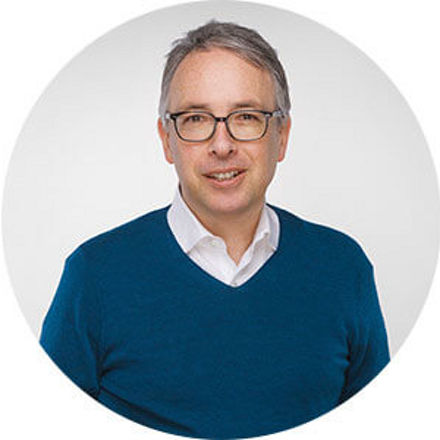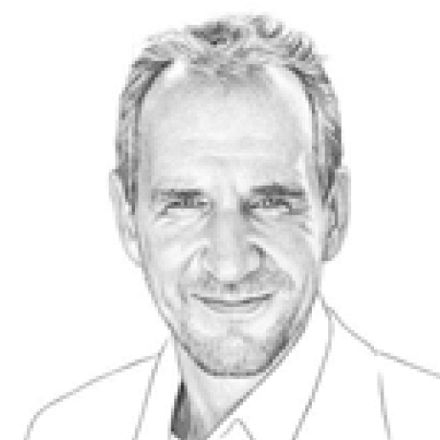If cars are equipped with electric motors instead of combustion engines, more than just the drive system will change. The infrastructure will also be shaken up, which raises questions: Where do we charge the vehicles, and how long will it take? Are there enough charging stations so that we don't get stuck on the road? Do we have enough raw materials for the e-batteries? Will electricity grids collapse if everyone charges their cars at the same time? And if fuel cell technology experiences a decisive boost in development - what then?
Honest answer: We don't know. We can't know. But we can run through the whole thing with the help of what-if scenarios, i.e. with images of possible developments. Even if they will never happen 100% of the time, such scenarios are definitely of value to companies: they allow them to prepare for what might come. The world is becoming faster-moving and more complex, and companies are adapting to this. The future refuses to be a linear business-as-usual; disruptions - nowadays usually called disruptions - are part of it.
GOAL: BE PREPARED FOR KEY DEVELOPMENTS
Groups often have their own corporate foresight departments to deal with such future issues. "The value of corporate foresight lies in the fact that companies can prepare for developments and are not caught off guard," says Cornelia Daheim, owner of Future Impacts, a consulting firm specializing in this field. However, companies sometimes find it difficult to look ahead. As a consultant for foresight projects, Daheim sees her main task as "questioning basic assumptions and thinking the unthinkable". And to do so in different variants, i.e. scenarios. A real challenge, says Daheim: "A company must first have the courage to stop taking the obvious for granted."
However, this courage is rewarded because it broadens the horizon and opens the eyes to unexpected opportunities and risks. Björn Theis, Foresight Manager at Evonik, explains this using the example of mobility. What would happen if self-driving cars were available in the future? The economy would be able to use this technology to increase the efficiency of goods transportation. In the private sector, the trend towards shared use of vehicles could increase: Owners of autonomous electric vehicles could conveniently rent out their vehicle to others via an app when they don't need it.
In such a scenario, the mileage of cars per day and therefore the wear and tear of individual components would increase significantly, and due to the large number of different users, there would be greater interest in antibacterial and hygienic interior materials, continues Theis. The materials used in the robo-taxis of the future would have to meet new requirements. For the Evonik Group, a specialty chemicals company that supplies products to the automotive supply industry, such a change in mobility behavior means changes in the market that need to be recognized.
FROM A WEAK SIGNAL TO A TREND
A futurologist’s job is complex and multi-layered. Above all, it requires an ability to think in holistic terms. Theis studied ethnology before deciding to focus on researching the future. He joined Evonik in 2014 after working for a consulting firm in the area of corporate foresight and helping to set up the Futures Studies master’s degree program at the Freie Universität Berlin.
Evonik’s Corporate Foresight department combines social, technological, economic, ecological, and political trends and their possible effects into holistic future scenarios and uses these scenarios to identify opportunities and challenges for the Group. Digitalization is one of the themes it investigates. “This is an important trend that can’t be overlooked, and it will therefore have a strong impact on the future of the specialty chemicals sector,” says Theis. But what does this mean for Evonik in concrete terms? To find out, Foresight team members talk to experts who are investigating the various facets of the digital transformation. What will be the impact of artificial intelligence in the future? What kind of work will it do? And where will it be used? What roles will robotics, cryptocurrencies, and virtual reality play in the chemical industry? There’s no end of the questions for which Theis and his team are seeking possible answers.

»We have to break the large whole into smaller pieces«
BJÖRN THEIS FORESIGHT MANAGER AT EVONIK
The creation of plausible and consistent scenarios is a lengthy and laborious process. Countless factors have to be analyzed and connected with one another. And the foresight experts don’t base this work on gut feelings or rough estimates. Futurologists have spent decades developing methods for identifying and analyzing trends. “Trends can be documented empirically and reliably. I know how these things develop,” says Andreas Neef, a Managing Partner of the Z_Punkt consulting firm, where Björn Theis used to work. Some sequences of phenomena are regarded as mere “weak signals.” “These are isolated events that only permit us to make assumptions,” Neef explains. Only if several weak signals come together do they slowly develop into a trend.
But even if the researchers have identified such a trend, in many cases it’s not clear what it will lead to. “The basic danger is always that we may overestimate or underestimate certain developments,” says Neef. He uses the “Fridays for Future” school strikes as an example. Is this a flash in the pan, or will the demonstrations grow into a global movement? There are still many “critical uncertainties” interacting with one another.
One of the approaches used by futurologists to represent these interactions is the “explorative scenario method.” They create concrete and consistent representations of how the world could look in the future. “A scenario tries to align the many different developments with one another and also to include their interactions,” says Neef. “Because this attempt can never be completely successful, we always look at several scenarios that assign more or less weight to certain aspects whose occurrence we consider more or less probable.” The companies don’t simply select their favorites from the scenarios that are offered to them. “Instead, they use all of the scenarios to derive a strategy that is as robust as possible.” In this context, “robust” means that the company can make preparations for the future no matter which scenario prevails.
INITIATING INNOVATIONS EARLY ON
Foresight Manager Theis and his colleagues also use this method to help Evonik initiate innovations purposefully and at an early stage and to review and further develop long-term strategies. The Foresight team has developed five scenarios for the period between now and 2040. In the “Digital Champions” scenario, the major Internet companies use their know-how and their mindset to tap an increasing share of the added value of traditional industries. The “Sustainability Paradigm” scenario describes how sustainability becomes the defining principle of economics. In the “Chinese Dream” scenario, China develops into a technological, economic, and political global force. In the “Turbulent Times” scenario, nationalism, fake news, and populist forces lead to ongoing deglobalization. The “Deceptive Calm” scenario looks at the future from another perspective. In a system based on “business as usual,” problems accumulate and possibly lead to collapse.

»Companies must gain the confidence to accept that what’s self-evident today may not be self-evident tomorrow«
CORNELIA DAHEIM OWNER OF THE FUTURE IMPACTS CONSULTING FIRM
These are five alternative courses of development that could become relevant to Evonik’s business operations in the medium to long term. In this context, Theis talks about “futures.” “We’re not making any forecasts, because there’s more than one possible future,” he says. The five scenarios worked out by Evonik’s researchers provide the company with a range of future options. Each variant is based on plausible and very well-founded assumptions and is logically deduced in four steps (see the graphic on the right).
The scenario project began with a question: What major forces will have an impact on specialty chemicals companies over the long term? “We’re looking at the major forces in the world,” says Theis. To this end, the team spent the past months interviewing over 100 in-house and external experts from the fields of science, politics, and business, assessing future studies, and conducting workshops. Their work resulted in a list of more than 100 factors that will have a profound impact on the specialty chemicals sector. They are subdivided under the headings Ecology, Politics, Society, Technology, and Economics.
In the second step, the experts reduced the multitude of influencing factors by selecting the key factors from the list according to certain specific criteria. These factors will have a substantial impact on the specialty chemicals sector. However, in many cases their future development is extremely uncertain, and they are also interacting with many other factors. The 25 factors that will have the strongest impact and form the basic framework of the scenarios were comprehensively analyzed and described. They include factors such as population growth, artificial intelligence, and climate change.
“In the third step, we asked how these key factors could plausibly develop in the future,” Theis explains. Between two and four future projections were derived for each key factor. In some cases, conflicting developments are possible. For example, it’s conceivable that biotechnology, including genetic engineering and artificial organisms, will receive worldwide acceptance—but it could also be banned.
Finally, in the fourth step the projections were connected with one another and assigned different weights. Within a network of stable and plausible relationships between the projections, the five computer-supported scenarios were created.
MAKING FORECASTS TO GAIN A COMPETITIVE EDGE
The scenario method was developed in the 1950s in several places including the RAND Corporation, a US think tank that was founded after World War II in order to advise the USA’s armed forces. Later on, companies including Motorola, General Electric, and UPS also assigned researchers the task of making it easier to calculate the future.
In the 1970s, corporate foresight created a genuine competitive advantage for the Shell Oil Company. The company’s managers had run several scenarios that played out what could happen if the supply of petroleum decreased. When OPEC imposed an embargo on oil deliveries to various industrialized nations in 1973, Shell was prepared and could react promptly. By the end of the oil crisis, Shell had become the world’s second-biggest and most profitable company in its sector. Back then, this success spurred other companies to also try their luck with the scenario method. However, many of these attempts were discontinued. It was evidently difficult to find the right path between methodological overengineering and superficiality.
Since that time, however, the methods have been considerably refined. René Rohrbeck, a corporate foresight expert who is a professor at Aarhus University in Denmark, deplores the fact that even today many companies are addressing the challenges of the future too hesitantly. “Even extremely convincing scenarios fail to reach their target if they are not channeled into strategic action,” he says.
Rohrbeck believes there are three main reasons why even well-meaning managers are not drawing the necessary conclusions. Many companies are overstretched by the rapid speed of change in markets and customer wishes. Because of the stringent demands of their daily work, managers don’t take the time to discuss future scenarios. In addition, companies often behave like supertankers: It takes them a long time to change course, especially if the change means calling currently profitable business areas into question without any guarantee of success.
HOW EVONIK DEVELOPS FUTURE SCENARIOS
1. Surveying the context
Which influencing factors will determine the future of the specialty chemicals sector?
2. Analyzing the key factors
Which factors have the most influence, and what are the relevant theme areas?
3. Developing projections
How could the individual factors develop in the future?
4. Creating scenarios
What do consistent combinations of projections look like, and how do they coalesce into scenarios?
ROBUST STRATEGIES FOR TOMORROW
At Evonik, decision-makers at all levels and in all the business areas of the Group were involved early on in the development of future scenarios. Chief Innovation Officer Dr. Ulrich Küsthardt is confident that the scenarios for Evonik’s long-term planning will create great added value. After all, they provide a basis for strategies that respond to the largest possible number of eventualities. “The ideal outcome would be a no-regrets decision that guarantees that you won’t do anything wrong,” says Küsthardt. However, even the very best scenarios won’t help the company make such a decision. “We don’t know the future; we only have well-founded ideas about what could happen,” says Küsthardt. “However, our goal is to develop optimally robust strategies for the innovation of tomorrow and beyond.”
On the way to this goal, the scenarios of the responsible strategy and innovation units are extensively discussed at Evonik. “We’re like chess players in this regard,” says Küsthardt. “We look at the various options and play them out.” For example, companies that want to be prepared for “Turbulent Times” must ask questions such as: Should we strengthen our regional and local units? If the world becomes less globally integrated, what will our future business relationships with customers, dealers, and suppliers look like? Do long-term contracts still have a future, or will contract terms become shorter? “It’s always a question of weighing up the issues. The discussion of the possibilities in itself already creates added value for the participants. And if concrete measures are then derived from the discussion, we’ve done a good job,” says Theis.
As a foresight manager at Evonik, he long ago stopped needing to persuade people that his approach was useful. “As soon as the managers realize how relevant the scenarios are for their work, they’re all fired up,” he says. Today the managers can’t wait to read the Corporate Foresight reports, says CIO Küsthardt, adding, “The managers have to make decisions and want to initiate activities. But they can only do that if they know what options they have.”

»The basic danger is always that we may overestimate or underestimate certain developments«
ANDREAS NEEF MANAGING PARTNER OF THE Z_PUNKT CONSULTING FIRM
The future: The time following the present
The future Various concepts of the future have developed over the course of history. Until the end of the ancient world, a cyclical view of history predominated. Instead of expecting progress, people believed in the eternal repetition of the past. In the Middle Ages, people conceived of the future as the descent of God from heaven. The Renaissance brought with it a rational concept of the future, marked by the works of Leonardo da Vinci. Powered by the Enlightenment, modern thought in the West is still shaped today by the belief that the future develops linearly and brings progress.
Renaissance
The epoch of European culture in the 15th and 16th centuries, at the boundary between the Middle Ages and the modern era.
Leonardo da Vinci (1452-1519)
Italian painter, sculptor, architect, and engineer
DECEPTIVE CALM
The world has changed since 2020—but only slowly and in small steps. There have been no drastic shifts in geopolitics, technology or social conditions. That has meant stability, robust economic growth, and business as usual. At the same time, the search for solutions to the major global problems has been repeatedly postponed, and as a result the negative consequences have become even more dire.
Initially, everything stayed the same. China did not manage to replace the USA as the dominant superpower. Global trade flourished, and the elimination of trade barriers led to a further increase of global value chains. This enabled numerous developing nations to attain relative prosperity during the past 20 years. The global middle class has increased by three billion people since 2020. Environmentally friendly concepts of consumption and mobility are playing a negligible role. The careless use of resources, the close collaboration of the oil-exporting states, and the lack of political will to shift to renewable energy sources has ultimately led to an increase in environmental damage, and the climate goals have been missed by a large margin. The Earth has been exploited far beyond its limits. The younger generation in particular no longer wants to bear the resulting social and economic costs—and is staging worldwide protests calling for a radical change of course and strict regulations.
The established companies, including those in specialty chemicals, are in a comfortable situation at the moment because of the growing demand for their products. The traditional business models are mostly intact. Profits are surging, and many new jobs are being created. Innovations such as 3D printing, light field displays, and service robots have become standard in many areas. However, the search for completely new technical solutions and materials and more environmentally friendly processes is secondary to aspects such as high quality at affordable prices, as well as quick and reliable delivery. Nonetheless, as the consequences of climate change become more drastic, people and legislators are demanding with increasing urgency that companies reverse the trends that are destroying the environment.

TURBULENT TIMES
The world of 2040 is deglobalized. Populist and authoritarian governments have pushed back democracy, press freedom, and an independent judiciary all over the world. The USA has lost its role as the global policeman, and no other superpower has replaced it. Nations are increasingly striving to promote their own interests, and the international community has been weakened. Instead of a free world order, there is a conflict-laden multipolar order in which global challenges such as climate change are being inadequately addressed.
The internal conditions of many countries reflect this picture: Societies are strongly polarized in their thinking, and they offer clashing ideologies concerning the right path to the future. Nongovernmental organizations exert massive influence on political decisions. Rational discussions are often hardly possible, because “fake news” are becoming more and more widespread. Technical progress is increasingly regarded as a threat: People are resisting the negative effects of automation and connectivity, such as mass unemployment and the increase of cybercrime. There are no effective solutions for the consequences of digital technologies, robotics, and artificial intelligence. In a world full of tensions, cyberwars are occurring with increasing frequency. This context poses huge challenges to business. The nationalism that is raging throughout the world is leading to trade wars and an increase of protectionism. Significant trade agreements have expired and been replaced by bilateral contracts, and the exchange of goods and capital is strongly regulated.
Champion nations are emerging in the areas of industry and business. Companies are making all of their activities more local, ranging from research and development to production and sales. They are also trying to create even closer relationships with customers and raw material suppliers. It’s becoming harder for companies to engage in a dialogue with all social groups, even though this dialogue is essential.

SUSTAINABILITY PARADIGM
By 2040 sustainability has established itself as the dominant economic principle and innovation driver. This has resulted not primarily from laws and regulations but especially from progress in green technologies and customers’ increased demand for sustainable solutions. That has led to two simultaneous developments: an ecological turnaround and a significant slowdown of climate change—thanks to digitalization, biotechnology, and affordable electricity from renewable sources.
Digital solutions have strongly accelerated the development, introduction, and monitoring of sustainable products and processes. Biotechnology is developing into one of the most important pacemakers of industrial processes, for example. In 2040 many chemicals can be manufactured cost-effectively with the help of modified microbes from biomass. The world is on track to leave the “age of oil” behind it and build up a circular bio-economy. Electricity from renewable sources is now so inexpensive that in many locations it has replaced other energy carriers in transportation and industrial processes. Recyclability is being increasingly taken into account during product development; as a result, the circular economy is continually gaining ground.
In a world where environmentally friendly products are mass-produced, sustainability is no longer regarded as a cost factor. Instead, sustainability is giving companies additional sources of revenue and offering them opportunities to set themselves apart from competitors. All stakeholders—shareholders, employees, and customers—expect companies to follow this path. The economy has significantly shrunk its CO2 footprint and is simultaneously operating more profitably than it did in the era of fossil fuels. An innovation only has a good chance of market success if it is more acceptable than a comparable solution. The procurement of biomass such as hay, straw, and algae is becoming increasingly important. In order to safeguard supply, some chemical companies are integrating themselves upstream into the agricultural, forest or algae industries. In many cases, they are shortening their transport routes by moving their plants closer to energy sources, suppliers or customers. Decentralization is the order of the day.

CHINESE DREAM
By 2040 China has regained the decisive global role it had already played during long stretches of history. It is setting the international agenda culturally, politically, militarily, and with regard to environmental protection. It has built up its power and influence step by step, first in Asia, then westward along the New Silk Road all the way to Europe, and finally worldwide. China has become a global superpower.
Never before has a national economy been so successful. China’s targeted industrial policy has efficiently promoted Chinese companies and massively advanced science and new technologies. The Chinese economy has seized its opportunity. Local companies have used their experiences and success in a growing domestic market, as well as their technological edge, to become serious competitors of Western companies in the global market. “Made in China” has become a mark of quality.
China is the leader in almost all the relevant technological fields: artificial intelligence, robotics, biotechnology, e-mobility, and environmental protection. In addition, the Chinese government has recognized and exploited the opportunity offered by digitalization: Three Chinese companies dominate the world’s mightiest digitalized economic system. Simultaneously, China has reorganized its economic and social structures. It is deliberately promoting low-CO2 lifestyles, environmental protection, green technologies and products, and clean production and energy. China has thus become the world’s first eco-civilization.
The established industries of the Western world are facing a strong new competitor; on the other hand, they can profit from a continually growing Chinese market. However, in order to do so they must adapt themselves even more precisely to Chinese customers and cooperate with Chinese companies. That’s the only way they can genuinely benefit from their innovative strength. The language and mindset of the new old superpower are also increasingly penetrating Western companies.

DIGITAL CHAMPIONS
The global digital champions have used their know-how and their well-filled “war chests” to gain ground in traditional sectors. Through their know-how they are occupying the interface with these sectors’ customers, thus acquiring considerable portions of the value creation of traditional industries. At the same time, companies are increasingly working together in horizontally networked ecosystems and establishing new digital business models.
This development is going hand in hand with growing individualization: Products and services are being more and more precisely adapted to customers. The concept of “economies of scale” is being replaced by “economies of access.” Ecosystems are combining their products and services for a certain need (such as mobility or healthcare) so that consumers can receive a whole spectrum of products and services from a single source.
By 2040, the technical preconditions for complex offers of this kind have been fulfilled: A full-coverage broadband network, as well as the use of artificial intelligence and quantum computing, are standard. Smart devices enable machines to communicate with one another and to share information. In daily life the smartphone has been replaced by devices that are controlled by means of the voice, gestures, eye movements or even thoughts. These technologies are even making virtual meetings possible—and thus drastically decreasing traffic volumes.
In this environment, traditional manufacturing companies must find a new role for themselves and try to develop their own ecosystems or to occupy the control rooms of these systems. The use of new digital technologies is urgently needed—especially in response to increased customer expectations (individualized products and services, fast delivery). Even small companies can access simple and inexpensive digital high-tech solutions, because the digital champions offer quantum computing as well as research and development services. Increasing automation may result in fewer people being employed in the areas of traditional production, whereas there is a strong demand for digital specialists.



